Home | City Notes | Restaurant Guide | Galleries | Site Map | Search | Contact
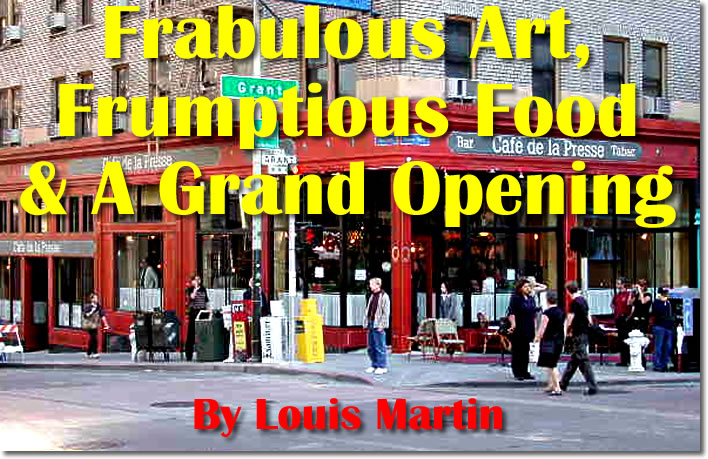
At Weinstein Gallery on Geary there is a couple from the midwest there when I walk in. They are overweight and wear shorts. I look at their knees while Russell Manning, gallery rep with the soul of a poet, gives them the basics on Thorpe. It goes something like this:
"His
father worked in a shipyard. He is the eldest of seven children. Consequently
the family always struggled financially. At the age of fifteen he 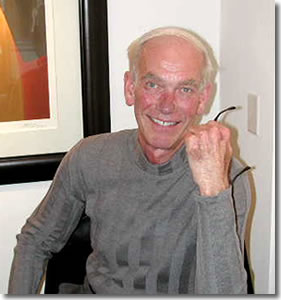 decided
to leave school and work in the shipyards along side his father ..." The
kness of the man in shorts looked pained.
decided
to leave school and work in the shipyards along side his father ..." The
kness of the man in shorts looked pained.
This was in Middlesbrough, England. "School was a miserable experience for him," says Russell. He had been taunted in school, both by students and teachers. He was dyslexic but no one knew that then. The knees of the woman in shorts looked sad.
Russell goes onto say that in the shipyard Thorpe seemed to find himself. And he found inspiration in the men who worked there. They became the subjects of some of his early drawings. Being poor, he drew on any paper he could find, including the insides of cigarette packages. When he was laid off at the shipyard, however, he felt humiliated and attempted suicide.
Says Russell, "He was talented. I think that is true of many dyslexic people. They are often very very bright but can't function in the more traditional way, and so they find other ways to compensate for that lack of ability."
Following his suicide attempt, an uncle urged him to apply to the local art college. Thorpe did, failed the written test, but got in based on a submission of his art.
Thorpe's story is one of struggle. Almost everyone has to overcome some adversity, but struggle seems to define Thorpe. Struggle and talent and a way of expression all his own. Eventually he found out that there was a name for his problem—dyslexia—and he studied it. After he got his art degree, he began visiting elementary schools and, says Russell, "using his art as a vehicle, sent the message to students, 'Don't let anyone tell you you can't.'"
One can enjoy Thorpe without knowing anything about him.
But the experience is better if you do. Take "Once in a Blue Moon" with
a guy struggling to pull a house up to the top of a big round hill. You
feel the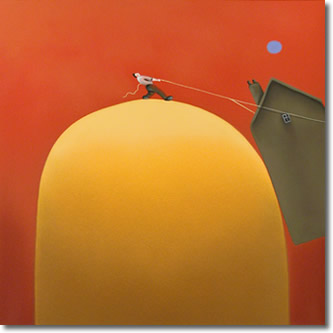 enormous
weight of the house balanced on the side of the hill and you also feel
the energy of the man bracing himself and pulling the rope. Its a little
like a shipyard worker hoisting cargo. It takes a man putting his full
energy into a task to make success seem possible. The blue moon over the
house? A statement that anything is possible.
enormous
weight of the house balanced on the side of the hill and you also feel
the energy of the man bracing himself and pulling the rope. Its a little
like a shipyard worker hoisting cargo. It takes a man putting his full
energy into a task to make success seem possible. The blue moon over the
house? A statement that anything is possible.
This is a lovely serigraph full of warm shaded color; it can be enjoyed all by itself. But it helps to know a little about Mackenzie Thorpe.
There is also "Hope from Despair." On the top of the hill a man is hanging from a gallows. There is blood at the base of the gallows that trickles down the side of the hill then rises back up in the form of a flower. Says Russell, "It's optimistic in spite of what it might first suggest to you." Without knowing the artist, he says, it might only seem morbid.
Know those days when all is despair? When the world is gray clouds and choppy water in an unfriendly sea? When getting out of bed ... Knowing those days helps you appreciate Thorpe.
I looked at the couple from the midwest, framed them in my mind with a blue background, and highlighted the flab around their knee caps. Do they have secret sorrows? A lost child? Something painful that is hard to forget? They are attracted to Thorpe and Thorpe to them. They ask Russell about shipping.
I think about Thorpe; I tried to pull the pieces of his
life together. I feel like the guy on the top of the hill tugging on ropes,
only my knees are weak, my wrists too fat. I'm afraid my description would
fail the written portion of an exam on Thorpe. Just go see him.
Harvey Dinnerstein was in town for the opening of a show at the Frey Norris Gallery. Harvey is a New Yorker who specializes in portraits of successful businessmen. Just kidding of course: New Yorkers. I asked him where he gets his material. He said he gets a lot of it on the subway. For example, he told me that the other day he saw a young man dressed in an old military uniform.
"You don't usually talk to people on the subway," he said.
But the young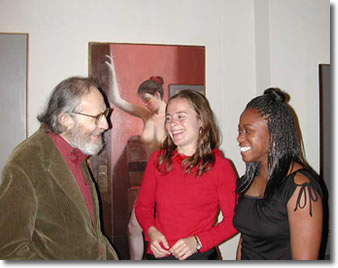 man was carrying some kind of long metal object, Harvey
was curious, and he finally asked him, "Is that a weapon or a musical
instrument?"
man was carrying some kind of long metal object, Harvey
was curious, and he finally asked him, "Is that a weapon or a musical
instrument?"
The young man started telling Harvey about his uniform, and he learned something he never knew before. He learned about the German volunteer army that fought on the side of the North in the American Civil War. The young man was wearing the uniform of a German volunteer soldier. Actually, the hat and the buttons were authentic. The uniform itself was a reconstruction, the young man told him. There is no portrait yet, but I'm sure Harvey is working on one.
Harvey caught my attention about a year ago when I made one of my usual rounds through the art galleries downtown. It's cheap entertainment on a Friday night and I often have a drink or two at Le Central, then head for the galleries.
What caught my attention about Harvey is his ability to
turn the people and things around him into art, always revealing
something unusual: New Yorkers in a subway, all wearing headphones, and
all in their own world. Or a nude woman where the attention is more on
the reddishness of her face than on her body. True, her breasts are large,
but why does her skin look so irritated? He sees the "disconnect" in
people, as in the folks with 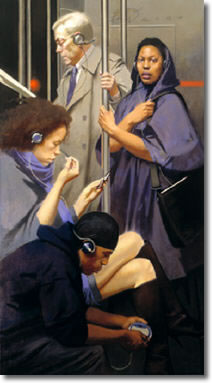 headphones,
the woman with the lantern ("Night
Shift"), or the woman wrapping her hands with tape before putting
on boxing gloves. It all looks perfectly natural, perfectly normal until
you stop and think about it. But he is not a critic, I think; he understands
his subjects and sees their beauty.
headphones,
the woman with the lantern ("Night
Shift"), or the woman wrapping her hands with tape before putting
on boxing gloves. It all looks perfectly natural, perfectly normal until
you stop and think about it. But he is not a critic, I think; he understands
his subjects and sees their beauty.
I asked Harvey if he added the reddish pimples to the face of the nude woman. "No," he says, "she looked exactly like that."
To turn the ordinary stuff of this world into art requires really seeing. Most people don't have the time. I know people who go through life never seeing half of what is around them. They walk to the bank and only see the bank; they never see the beggar on the corner with the paper cup. And there are "advanced" artists who only see abstractions. But Harvey sees the world around him and out of a million moments captures the one that tells, or at least suggests, a story about his subject. There should always be a little mystery, he says.
Harvey is a wry humorous guy who loves the world around him, and it is hard not to like this guy in his seventies whose eyes sparkle with wonder and curiosity. He is a guy, like Whitman, who knows of "nothing but miracles." What else does he see on the subway? The black folks, he says, the "energy in their hair."
"Can you recommend a restaurant?" he asked. I told him about Enrico's on Broadway, the French bistros on Belden, and Jeanty Jack's all by itself on Sacramento. I mentioned that Jack's had made it through the '06 quake and that there were old photographs of Marlene Dietrich, Earnest Hemingway, Alfred Hitchcock ..."
"That sound like my place," he said.
Not totally dysfunctional on Monday but headed that direction, I decided to go over to Rosewood in North Beach for a meeting of the San Francisco Bartender's Guild. No, I'm not a part-time bartender. I'm a consumer with an interest in cocktails and I find these meetings inspirational. For some it is church; for me it's a bar.
This was not an ordinary meeting, however. It was a special event sponsored by Pitu cachaca, a clean spirit made from pure sugar cane in Brazil. There was to be a reception, a seminar, and a mixing contest. I missed the contest but was there for the reception and the seminar.
Now
the nice thing about meetings with bartenders is that they have the perspective
down, unlike a lot of business folks. If something doesn't quite work,
so what; have another drink, let's talk. You have
a hard day to day baby? Oh, poor baby, let me mix you something; now
sit down and tell me all about it. Ever hear a business
guy talk like that? What do you
mean you can't deliver the doogers on time. My guys need the doogers
now! Who
cares about doogers anyway? And what is a dooger?
you
mean you can't deliver the doogers on time. My guys need the doogers
now! Who
cares about doogers anyway? And what is a dooger?
Anyway, as I said, these are my kind of meetings. At the reception the Rosewood bar was churning out Caipirinhas and Mojitos faster than a motherfucker. Motherfucker? You'll have to excuse me; I've been listening to Miles Davis' "Kind of Blue" and I think it has altered my vocabulary. I'm not sure what is going on. Miles was one bad-ass dude, by the way.
Martin Friedman (photo, left), rep for the importer of Pitu, thought I might be interested in knowing that the Brazilian consul was at the meeting. I was. In the back of Rosewood, by a table loaded with odeuvres, I found a guy who looked like he might be the consul; you know, dark suit, tie, and did not look like a bartender. "Deputy Consul," he informed me, drink in one hand, small sandwich in the other. I remarked that he must at times have more important events to attend than ones of this type. "I prefer this type," he said with a smile and took a bite of his sandwich.
Pitu is trying to promote itself over Vodka. They claim it is purer than Vodka and that women like it. I don't know about this "women like it" thing. Does that make me like it? What if I don't like women? I do, mind you, but what if I didn't? Or are they suggesting that I give it to some knock-out babe and then seduce her? Not sure. Why not claim people like it? Or that smart people like it. Or that intelligent and cultured people prefer it to anything else in the world. But "women"? I think they need to watch that one.
 Anyway, do drink the stuff; it makes a terrific drink.
And, as they claim, it is clear. It's not going to replace
Ketel One for me, but I am giving it a try.
Anyway, do drink the stuff; it makes a terrific drink.
And, as they claim, it is clear. It's not going to replace
Ketel One for me, but I am giving it a try.
Tony Abou-Ganim (photo, right) conducted the "seminar" which was not too serious and not too long. He talked about what makes a great cocktail without being too specific: "You put that little extra love in and care about what you're serving your guests; you give them an experience instead of just a drink." He goes onto quote from "Straight Up On The Rocks" by William Grimes:
Bartending, once a proud profession, is now a pit stop between acting gigs ... The possibility that we will ever see making cocktails like the Martini and the Manhattan ever again seems remote.
Sad words indeed. But dig this: Part of the purpose of the Bartender's Guild is to reverse that trend, and San Francisco and its chapter of the Bartender's Guild are doing just that. Praise the lord and pass the bottle.
There was a long list of well know bartenders at the event, including Dave Nepove of Enrico's, Marco Dionysus of Peces, Jaques Bezuiedenhout, also of Peces, and Thomas Waugh of Encrico's. All these guys are topnotch bartenders, and if drinks were houses, they would all be on the top of the hill.
While I showed up at the event somewhat dysfunctional,
I left in good shape, thinking Thorpe all the way home.
Now what some had begun to doubt has finally happened: Cafe de la Presse has reopened. Aqua bought this prime location on Grant and Bush some six months ago and in late Spring shut it down for remodeling. While they missed their target date for reopening—mid August—they just had their Grand Opening. And Grand it was, maybe even Fabulous, if you like such words. Maybe even Frabulous or Frubulous. Lewis Carroll would have loved it.
Now the extra month may be explained
by the piles of olives, pates, frites, spreads,
dips, cheese platters, plates of this, trays of that, bottles of wine,schmottles
of brine,  champagne,
jampagne, phampage, varieties and vorietelles of pastis and bastis—yes
almond, mint, cranberry, franferry, and more—that helped celebrate
this event. And all the big brass from Aqua was there: Laurent Monrique
(photo, left), the executive chef, Jean Claude Persais, vice president
of "operations," Maria Hilario-Fendert (photo, left), General
Manager of Cafe de la Press and a knockout-looking babe ... Now I wonder
what she would think of Pitu? Pitu
for you my who of how and why of which? Thorpe you are so fine! Why
can't I get your hills out of my heart? My heart is like a yellow hill
of brill. Is anyone really going to understand this? And does it matter?
What I didn't say about Thorpe was that his childhood was dreary and
he was the eldest of seven children in a working-class town and his mother,
I think, was a nurse. "Really?" "I think so."
champagne,
jampagne, phampage, varieties and vorietelles of pastis and bastis—yes
almond, mint, cranberry, franferry, and more—that helped celebrate
this event. And all the big brass from Aqua was there: Laurent Monrique
(photo, left), the executive chef, Jean Claude Persais, vice president
of "operations," Maria Hilario-Fendert (photo, left), General
Manager of Cafe de la Press and a knockout-looking babe ... Now I wonder
what she would think of Pitu? Pitu
for you my who of how and why of which? Thorpe you are so fine! Why
can't I get your hills out of my heart? My heart is like a yellow hill
of brill. Is anyone really going to understand this? And does it matter?
What I didn't say about Thorpe was that his childhood was dreary and
he was the eldest of seven children in a working-class town and his mother,
I think, was a nurse. "Really?" "I think so."
But I also noted the "little" people there too, like Amy
the bartender from New Orleans.  She moved here just a couple of weeks ago.
"Katrina?" I asked. "No, I was planning to move to San Francisco anyway."
She moved here just a couple of weeks ago.
"Katrina?" I asked. "No, I was planning to move to San Francisco anyway."
I asked her if she could do a Sazerac cocktail. I put it this way, "Can you do a Sazerac cocktail?" She smiled at the mention of that wicked little drink with all the bitterness of Peychaud.
"No rye whiskey," she said sadly. I thought she was going to cry.
"You can make it with Bourbon," I shouted at her. "Don't be stupid!" I howled jumping onto the bar with a knife.
"Wouldn't be the same," she said as though lost in some sad memory of a forgotten love.
I said, "I'm so sorry," and wept, my tears making puddles on the bar. Did she too have weak knees and fat writs?
I agreed but Bourbon does work. You can also make it with Cognac, as Antoine Peychaud, the inventor of this drink, did before he sold it to the Sazerac Coffee House and they substituted rye for cognac. Damn you, Peychaud, why did you have to sell to those bastards. Damn you, damn you, damn you!
Jezze, what is going on here? Getta grip! Gotta grope! Getta groupa grop. Just finish the damn thing. What are readers going to think? They sure ain't going to dig this, Lester. Birth of the Cool? Death of a fool!
So the question on everyone's
mind is this: How is the new place, how does it compare to the old?
I'm sure there will be lots of opinions on this, but here's mine: Aqua
has put a lot of work into this place to make it topnotch. They have
also retained all the motifs of the old place: Outside tables for casual
food and drink on the corner. The newspaper rack has moved to the other
wall but is new: big beautiful stained-wood rack. Hard to complain
about that. Classy French bistro bar now in the middle where the grungy
old counter used to be. And more tables around the window side where
newspaper rack used to be. Means more window space, which is a good
idea. Now the restaurant: Again nice stained woodwork but a little
noisy due to hard walls and a high ceiling. Maybe they will find a 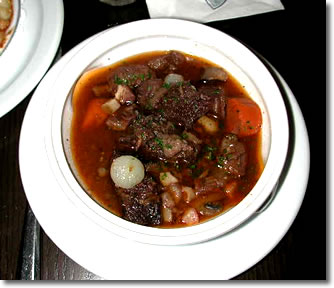 way
to soften the noise. The wait staff is new and is still bumping into
each other as they get the routine down. That is normal. There should
be fewer collisions as time goes on. And finally the food: Good traditional
French dishes: Steak frite, Beef bourgogne, scallops ... There is
also a separate bar menu.
way
to soften the noise. The wait staff is new and is still bumping into
each other as they get the routine down. That is normal. There should
be fewer collisions as time goes on. And finally the food: Good traditional
French dishes: Steak frite, Beef bourgogne, scallops ... There is
also a separate bar menu.
Now ponder this one: The price is not cheap. But remember the old place? Remember the three-dollar latte that you drank out front? Remember how long it took to get and how slow the waiter was bringing the bill? Compare the new place to this and I think you have to feel like a happy customer. Cafe de la Press is now more than a "location". Compare it also to Cafe Espresso on Mason and Sutter, also a prime corner location with a similar bistro look. I like that place for reasons unknown, but others find it a tourist trap that does not deliver. I understand how they feel. But don't expect tears from me.
Anyway, you gotta give these guys credit for a truly grand opening. Salut, Cafe de la Press! If Thorpe were here, he would tell you there was hope but not for me; if Harvey were here, he'd have spotted the unhappy-looking Asian woman in low-cut blouse clutching the cranberry pastis. Or was it the franbeery bastis? Pitu pitu pitu.
Home | City Notes | Restaurant Guide | Galleries | Site Map | Search | Contact